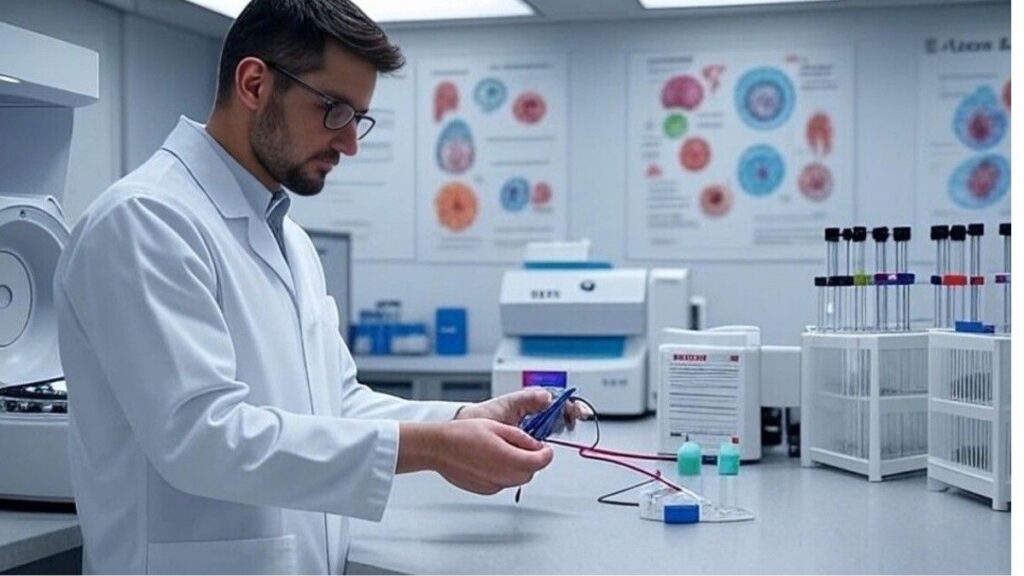
Introduction
Acute Hepatitis Panel :The liver plays a crucial role in maintaining overall health and body functions. It works to detoxify harmful substances, make bile which is used for digestion, store energy and control metabolism. But when the liver is attacked by virus, poison or the immune system, its work can quickly deteriorate.
The most common and dangerous cause of sudden inflammation in the liver is viral hepatitis.
The Acute Hepatitis Panel is a special group of blood tests that determines whether the patient has a recent or ongoing hepatitis infection and which virus is responsible.
These tests are a good way of early diagnosis, which can allow timely treatment to be started and prevent major complications such as liver failure, cirrhosis, or chronic hepatitis.
In this detailed guide you will discover:
- What is Acute Hepatitis Panel and why it is important
- Which viruses does it detect and how
- Which consumables are used in the laboratory
- Step-by-step procedure of the test
- Preparation before the test
- How the results are understood
- Risks and limitations
- FAQs that clear common doubts
- And a professional disclaimer
Understanding Acute Hepatitis
‘Acute’ means a sudden onset liver inflammation that usually lasts for less than 6 months. Its causes can be:
- Viral infections – Hepatitis A, B, C, D, E (Panel checks A, B, C more)
- Effect of medicine or poison – like acetaminophen overdose or poisonous chemical exposure
- Excessive use of alcohol – sudden exposure to excessive alcohol consumption
- Autoimmune hepatitis – a condition where the immune system mistakenly targets and damages liver tissue
Viral hepatitis does not show many symptoms in the early stage, but in the acute phase these signs can appear:
- Yellowing of skin and eyes (jaundice)
- Sickness and weakness
- Loss of appetite
- Vomiting or bleeding
- Dark coloured urine, pale coloured stool
- Pain in the right upper abdomen
What is Acute Hepatitis Panel is?
This is a bundle blood test that detects antibodies and antigens for Hepatitis A, B, and C.
| Virus Tested | Marker Detected | Purpose |
| Hepatitis A Virus (HAV) | HAV IgM antibody | Indicates recent/acute Hepatitis A infection |
| Hepatitis B Virus (HBV) | HBsAg (surface antigen) | Indicates current infection and contagiousness |
| Hepatitis B Virus (HBV) | IgM anti-HBc (core antibody) | Indicates recent/acute HBV infection |
| Hepatitis C Virus (HCV) | Anti-HCV antibody | Indicates exposure; RNA test is needed to confirm active infection |
Why do doctors order this panel
If:
- Reason for jaundice is not understood
- Liver function test is abnormal
- There are symptoms of viral hepatitis
- Recent contact with a patient who was hepatitis positive
- Exposure to contaminated water/food (HAV)
- Risk factors such as IV drug use, unsafe sexual contact, needle injury
- Doctor needs to confirm the type of virus so that targeted treatment can be done
Lab Consumables used in the test
For blood collection:
- Vacutainer tubes (red-top or SST)
- Sterile needles (21–23 gauge)
- Alcohol swabs
- Tourniquet
- Disposable gloves (nitrile or latex-free
- Cotton balls or gauze
- adhesive tape
For Sample Processing:
- centrifuge tubes
- Sterile micropipette tips
- Biohazard bags
For Laboratory Testing:
- ELISA-based diagnostic kits (used for detecting HAV IgM, HBsAg, HBc IgM, and anti-HCV)
- Chemiluminescent immunoassay reagents
- Microplates
- Positive & negative controls
- Buffer & wash solutions
- Stop solution & substrate
For Waste Disposal:
- sharps containers
- Biohazard waste containers
Step-by-Step Procedure
1. Patient Preparation
- Fasting is not required
- Explain the procedure to the patient
- Label the tubes
2. Blood Collection
- Disinfect the arm with alcohol
- Identify the vein by applying a tourniquet
- Collect blood using a needle
- Remove the needle and apply pressure with cotton/gauze
3. Sample Processing
- Allow the blood to clot (for serum)
- Separate the serum by centrifuging
- Transfer the serum to a sterile tube
4. Laboratory Testing
- Test the serum using ELISA or chemiluminescence method
- Detect antigen-antibody reactions
- Validate the result with controls
5. Reporting
- Results are sent to the physician for interpretation
Interpretation of Results
- HAV IgM positive – Recent Hepatitis A
- HBsAg positive – Active Hepatitis B, patient is infectious
- IgM anti-HBc positive – Recent Hepatitis B
- Anti-HCV positive – indicates past or recent exposure to HCV; confirmation requires an HCV RNA test
Risks & Limitations
Risks:
- Slight pain, bruising, dizziness after blood draw
Limitations:
- Early infection can be missed
- False positive/negative possible
- Panel only covers A, B, C – not D, E
Ways to avoid Hepatitis
- Vaccination – available for HAV and HBV
- Safe food & water – To avoid HAV
- Avoid needle sharing – Specially for HCV, HBV
FAQs
In 1–3 working days.
No, this is only for acute infections.
Generally no, but it is important to inform the doctor.
Post-exposure prophylaxis (vaccine or immune globulin) may be given early for HAV and HBV.
Disclaimer
This content is for educational purposes only. Always consult a qualified healthcare provider for your health-related decisions.